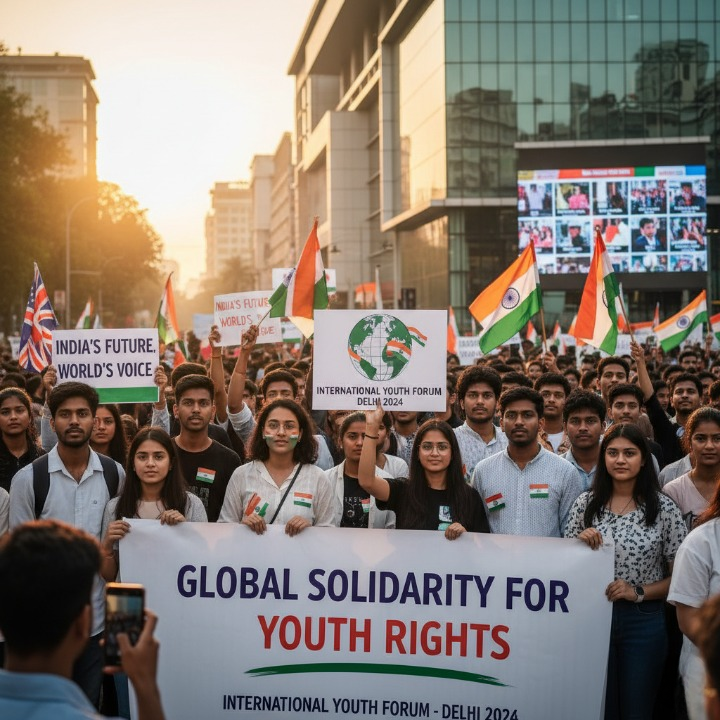How global trends inspire activism and shape the political consciousness of young Indians.
Introduction
In an interconnected world, international movements significantly influence the political engagement and activism of Indian youth. From climate change to gender equality, global campaigns have ignited awareness, shaped ideologies, and catalyzed action among young Indians. As India’s youth—comprising over 65% of the population under 35—engages with these global trends, they contribute to a dynamic political landscape that bridges local concerns with international ideals. This article explores the ripple effects of international movements on Indian youth politics.
Global Movements Influencing Indian Youth Politics
1. Climate Action: Fridays for Future
The international climate movement, spearheaded by Greta Thunberg’s Fridays for Future (FFF) campaign, has inspired Indian youth to take a stand against environmental degradation.
- Impact in India:
- Indian chapters of FFF have organized protests and campaigns against deforestation, air pollution, and unsustainable development projects.
- Movements like the Save Aarey Forest campaign in Mumbai gained traction due to global climate advocacy.
(Source: Fridays for Future India)
2. Gender Equality: #MeToo Movement
The global #MeToo movement, which began in Hollywood, resonated deeply in India, triggering a wave of revelations about workplace harassment and gender inequality.
- Impact on Youth Politics:
- Young Indian activists have pushed for stronger legislation on women’s safety and gender parity in educational institutions and workplaces.
- Student unions have demanded the implementation of stricter anti-harassment policies on campuses.
(Source: Ministry of Women and Child Development)
3. Black Lives Matter and Anti-Discrimination Movements
The Black Lives Matter (BLM) movement has influenced Indian youth to address systemic discrimination and caste-based inequalities.
- Impact:
- Conversations on casteism, racism, and privilege gained momentum on social media platforms, leading to youth-led protests and campaigns.
- Movements like Dalit Lives Matter have drawn inspiration from BLM, highlighting caste-based violence and discrimination in India.
(Source: UNESCO India)
4. Digital Activism: Arab Spring and Beyond
The Arab Spring, which showcased the power of social media in mobilizing political movements, has inspired Indian youth to leverage digital platforms for activism.
- Impact:
- Campaigns such as Net Neutrality and opposition to internet shutdowns have been driven by tech-savvy Indian youth.
- Platforms like Twitter and Instagram amplify student-led protests and grassroots movements across the country.
(Source: Digital India)
Key Transformations in Indian Youth Politics
1. Enhanced Awareness and Global Perspective
International movements have broadened the horizons of Indian youth, connecting local struggles with global narratives.
- Examples:
- Youth activists addressing LGBTQ+ rights in India draw inspiration from global Pride movements.
- Climate action in India aligns with international commitments under the Paris Agreement.
(Source: UN Framework Convention on Climate Change)
2. Greater Use of Technology for Advocacy
The influence of international movements has underscored the importance of digital tools in mobilizing support and raising awareness.
- Examples:
- Online petitions against controversial policies.
- Virtual campaigns demanding accountability from public officials.
3. Bridging the Local-Global Divide
Indian youth increasingly adopt a dual approach—leveraging international strategies to address local issues like caste discrimination, gender violence, and environmental degradation.
Challenges of Adopting International Movements
1. Cultural and Societal Barriers
Global movements often face resistance when adapted to India’s diverse cultural landscape, leading to misinterpretation or backlash.
2. Limited Grassroots Reach
While urban youth are quick to adopt global trends, rural communities often remain disconnected due to limited access to information and digital platforms.
3. Risk of Superficial Engagement
International movements can sometimes result in performative activism, where focus on symbolism outweighs actionable change.
Strategies for Effective Engagement
1. Contextualizing Global Narratives
Youth activists must tailor international movements to address India’s unique socio-political challenges, ensuring relevance and impact.
2. Strengthening Collaboration
Collaborating with grassroots organizations and local leaders can bridge the gap between urban and rural youth participation.
3. Promoting Digital Literacy
Expanding access to digital tools and training in rural areas can democratize activism and amplify marginalized voices.
Opinionated Yet Balanced Perspective
International movements provide Indian youth with a powerful framework to address systemic issues and drive political engagement. However, meaningful impact requires moving beyond imitation to integration, ensuring that global ideals resonate with local realities.
Conclusion
The impact of international movements on Indian youth politics underscores the interconnectedness of global and local struggles. As young Indians draw inspiration from these movements, they bring fresh perspectives and innovative strategies to the political arena. By contextualizing global ideas and addressing India’s unique challenges, the youth can transform activism into actionable governance, shaping a future that reflects both global ideals and local aspirations.


Leave a Reply